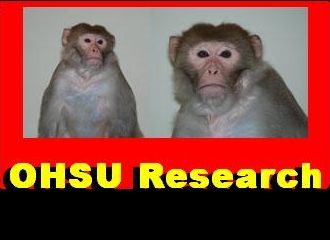
Publisher:
Bonnie King
CONTACT:
Newsroom@Salem-news.com
Advertising:
Adsales@Salem-news.com

~Truth~
~Justice~
~Peace~
TJP
Nov-14-2007 22:01

 TweetFollow @OregonNews
TweetFollow @OregonNews
Breakthrough Called a Significant Step forward in Stem Cell Therapies
Salem-News.comThe breakthrough follows several previously unsuccessful attempts by the OHSU and other scientific teams worldwide.
 Monkeys from the National Primate Research Center Courtesy: OHSU |
(PORTLAND, Ore.) - Researchers at Oregon Health & Science University’s Oregon National Primate Research Center have made a significant breakthrough in efforts to develop human stem cell therapies that may be used to combat numerous devastating diseases.
For the first time, scientists say they have successfully derived embryonic stem cells by reprogramming of genetic material from skin cells while studying rhesus macaque monkeys.
The breakthrough follows several previously unsuccessful attempts by the OHSU-based team and other scientific teams worldwide. The results of the work were released online today by the scientific journal Nature. The work will also be published in next week’s edition of the journal.
Prior to the OHSU team’s recent success in a species closely related to humans, scientists worldwide have isolated stem cells only in mice using a technique called somatic cell nuclear transfer. The method involves transplanting the nucleus of the cell, containing an individual’s DNA, to an egg cell which has had its genetic material removed. For various reasons and despite numerous attempts, previous efforts to use the SCNT technology to clone stem cells in primates have failed repeatedly.
“Many scientists believe that embryonic stem cells hold great promise for treating a variety of diseases including Parkinson’s disease, multiple sclerosis, cardiac disease and spinal cord injuries,” explained Shoukhrat Mitalipov, Ph.D., director of the OHSU-based research team and an assistant scientist in the Division of Reproductive Sciences at ONPRC, the Oregon Stem Cell Center and the department of Obstetrics and Gynecology of Oregon Health & Science University. Don Wolf, Ph.D. of the primate center also played a significant role in the research.
“Using our advanced methods, it is conceivable that years from now, patients could receive therapeutic embryonic stem cells developed from their very own cells meaning that there would be no concerns about transplant rejection. Another noteworthy aspect of this research is that it does not involve the use of fertilized embryos, a topic which has been the source of a significant ethical debate in this country. ”
The Munroe-Meyer Institute and the Whitehead Institute for Biomedical Research collaborated with OHSU to conduct this research. The studies were funded by the Oregon National Primate Research Center, the National Center for Research Resources, and the National Institute of Neurological Disorders and Stroke, both components of the National Institutes of Health.
Story continues below
“This advance at the Oregon National Primate Research Center builds on studies supported over several years by the NCRR aimed at understanding the basic biology of stem cells and at developing methods to investigate non human primate models of disease,” said John D. Harding, Ph.D., NCRR's Director of Primate Resources. “These studies have great potential to accelerate progress in the field of regenerative medicine.”
The reason why Mitalipov’s team was successful when so many other previous attempts were not, lies in the method for identifying and extracting the nuclei of the eggs being used. Prior attempts resulted in damaged eggs due to the difficulties involved in removing the nucleus. This means that the eggs were not fully functional and failed to divide and develop.
To conduct the research, researchers obtained skin cells from a nine-year-old male rhesus macaque monkey at the Oregon National Primate Research Center. The researchers then used specialized imaging software called, Oosight Spindle Imaging System, to spot and remove the nuclear material attached to the egg’s spindle fibers. The nuclei of skin cells were then inserted into nucleus-free eggs. Using this technique, two embryonic stem cell lines - groups of cells that can grow indefinitely and differentiate into any cells of the body- were successfully developed. The genetic material (DNA) of cell lines was then matched to DNA from the male donor male monkey to ensure that they were a direct clone.
Successful development of the cell lines required numerous attempts. Overall, 304 monkey eggs (oocytes) from 14 female rhesus monkeys were used to generate the two embryonic stem cell lines, a .7 percent success rate
“While development of the stem cell lines required hundreds of attempts, this research proves it can be done and will likely lead to refinements which will make the process more efficient and lead to a higher success rate,” explained Mitalipov. “This is the next step for our research team as other scientists continue to investigate the promise of stem cell therapies.”
Source: OHSU
Articles for November 13, 2007 | Articles for November 14, 2007 | Articles for November 15, 2007

Quick Links
DINING
Willamette UniversityGoudy Commons Cafe
Dine on the Queen
Willamette Queen Sternwheeler
MUST SEE SALEM
Oregon Capitol ToursCapitol History Gateway
Willamette River Ride
Willamette Queen Sternwheeler
Historic Home Tours:
Deepwood Museum
The Bush House
Gaiety Hollow Garden
AUCTIONS - APPRAISALS
Auction Masters & AppraisalsCONSTRUCTION SERVICES
Roofing and ContractingSheridan, Ore.
ONLINE SHOPPING
Special Occasion DressesAdvertise with Salem-News
Contact:AdSales@Salem-News.com


Salem-News.com:

Terms of Service | Privacy Policy
All comments and messages are approved by people and self promotional links or unacceptable comments are denied.
[Return to Top]
©2025 Salem-News.com. All opinions expressed in this article are those of the author and do not necessarily reflect those of Salem-News.com.